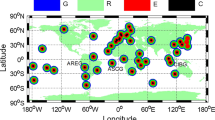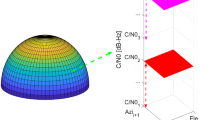Abstract
To mitigate multipath effects in multi-GNSS and multi-frequency precise point positioning (PPP), we constructed multi-GNSS and multi-frequency multipath models using the multipath hemispherical map (MHM) method. We investigated multi-GNSS and multi-frequency multipath effects by analyzing the impact of multipath corrections on observation residuals and PPP performance. In general, greater code rates and signal strengths lead to smaller observation residuals and multipath corrections, and signals with better anti-multipath performance are obtained. Notably, the observation residuals and multipath corrections of the GPS L5 signals are the smallest among those of the triple-frequency signals, and those of the GLONASS G1 signals are smaller than those of the G2 signals. Among the Galileo five-frequency signals, those of the E1 and E5 signals are the largest and smallest, respectively. Among the BDS-3 five-frequency signals, those of the B1I and B1C signals are greater than those of the other signals. Additionally, overlapping frequency signals with the same code rates and similar signal strengths display similar observation residuals and multipath corrections. In particular, the BDS-3 B1C signal has large phase residuals in the high-elevation region, possibly due to inaccurate receiver antenna phase center corrections applied. Surprisingly, the MHM method works well on it, possibly because the phase multipath corrections include elevation-specific errors. After multipath correction, the low-frequency multipath errors of multi-GNSS and multi-frequency observations are efficiently mitigated, significantly reducing the observation residuals and improving the observation accuracy. As a result, the three-dimensional convergence time of multi-GNSS and multi-frequency float kinematic PPP is reduced by 24.1%, with a 13.8% improvement in the positioning accuracy.













Similar content being viewed by others
Data availability
The IGS Global Data Center and Analysis Center of Wuhan University are acknowledged for supplying global station data and precise products (ftp://igs.gnsswhu.cn/pub/whu/MGEX/).
References
Atkins C, Ziebart M (2016) Effectiveness of observation-domain sidereal filtering for GPS precise point positioning. GPS Solut 20(1):111–122
Bock Y (1991) Continuous monitoring of crustal deformation. GPS World 2:40–47
Choi K, Bilich A, Larson K, Axelrad P (2004) Modified sidereal filtering: implications for high-rate GPS positioning. Geophys Res Lett 31(22):L22608
Cohen CA, Parkinson BW (1991) Mitigating multipath error in GPS based attitude determination. Adv Astronaut Sci 74:53–68
Dong D, Fang P, Bock Y, Webb F, Prawirodirdjo L, Kedar S, Jamason P (2006) Spatiotemporal filtering using principal component analysis and Karhunen–Loeve expansion approaches for regional GPS network analysis. J Geophys Res Solid Earth. https://doi.org/10.1029/2005JB003806
Dong D, Wang M, Chen W, Zeng Z, Song L, Zhang Q, Cai N, Cheng Y, Lv J (2016) Mitigation of multipath effect in GNSS short baseline positioning by the multipath hemispherical map. J Geod 90:255–262
Fuhrmann T, Luo X, Knöpfler A, Mayer M (2015) Generating statistically robust multipath stacking maps using congruent grids. GPS Solut 19(1):83–92
Johnston G, Riddell A, Hausler G (2017) The international GNSS service. In: Teunissen PJG, Montenbruck O (eds) Handbook of global navigation satellite systems, 1st edn. Springer, Cham, pp 967–982
Lu R, Chen W, Dong D, Wang Z, Zhang C, Peng Y, Yu C (2021) Multipath mitigation in GNSS precise point positioning based on trend-surface analysis and multipath hemispherical map. GPS Solut 25:119
Lu R, Chen W, Zhang C, Li L, Peng Y, Zheng Z (2022) Characteristics of the BDS-3 multipath effect and mitigation methods using precise point positioning. GPS Solut 26(2):41
Lu R, Chen W, Li Z, Dong D, Jiang W, Wang Z, Huang L, Duan X (2023) An improved joint modeling method for multipath mitigation of GPS, BDS-3, and Galileo overlapping frequency signals in typical environments. J Geod 97(10):95
Ollander S, Bode FW, Baum M (2018) Multi-frequency GNSS signal fusion for minimization of multipath and non-line-of-sight errors: a survey. In: 2018 15th workshop on positioning, navigation and communications (WPNC). IEEE, pp1–6
Qu L, Wang L, Acharya TD, Du Y, Wang H, Jiang W (2023) Global single-epoch narrow-lane ambiguity resolution with multi-constellation and multi-frequency precise point positioning. GPS Solut 27(1):29
Ren H, Li G, Geng J, Wang F, Li P (2023) Multipath hemispherical map model with geographic cut-off elevation constraints for real-time GNSS monitoring in complex environments. GPS Solut 27(4):188
Seepersad G, Bisnath S (2015) Reduction of PPP convergence period through pseudorange multipath and noise mitigation. GPS Solut 19:369–379
Wang K, Khodabandeh A, Teunissen PJ (2018) Five-frequency Galileo long-baseline ambiguity resolution with multipath mitigation. GPS Solut 22:1–14
Wang Z, Chen W, Dong D, Wang M, Cai M, Yu C, Zheng Z, Liu M (2019) Multipath mitigation based on trend surface analysis applied to dual-antenna receiver with common clock. GPS Solut 23:1–15
Wang Z, Chen W, Dong D, Zhang C, Peng Y, Zheng Z (2020) An advanced multipath mitigation method based on trend surface analysis. Remote Sens 12:3601
Yuan H, Zhang Z, He X, Dong Y, Zeng J, Li B (2023) Multipath mitigation in GNSS precise point positioning using multipath hierarchy for changing environments. GPS Solut 27(4):193
Zhang F, Chai H, Wang M, Bai T, Li L, Guo W, Du Z (2023) Considering inter-frequency clock bias for GLONASS FDMA+CDMA precise point positioning. GPS Solut 27(1):10
Zheng K, Zhang X, Li P, Li X, Ge M, Guo F, Sang J, Schuh H (2019) Multipath extraction and mitigation for high-rate multi-GNSS precise point positioning. J Geod 93:2037–2051
Zheng K, Tan L, Liu K, Li P, Chen M, Zeng X (2022) Multipath mitigation for improving GPS narrow-lane uncalibrated phase delay estimation and speeding up PPP ambiguity resolution. Measurement 206:112243
Acknowledgements
This study was partially supported by the National Natural Science Foundation of China (No. 42104026) and the Natural Science Foundation of Beijing Municipality (No. 8222011).
Author information
Authors and Affiliations
Contributions
LQ was involved in conceptualization, methodology, software, writing—review and editing, formal analysis, and funding acquisition; WJ contributed to investigation, methodology, software, validation, writing—original draft, and visualization; JL contributed to resources, data curation, and validation; YD contributed to validation, visualization; HW and LW contributed to Investigation; JW contributed to supervision, and funding acquisition. All authors read and approved the final manuscript.
Corresponding author
Ethics declarations
Conflict of interest
All authors certify that they have no affiliations with or involvement in any organization or entity with any financial interest or non-financial interest in the subject matter or materials discussed in this manuscript.
Additional information
Publisher's Note
Springer Nature remains neutral with regard to jurisdictional claims in published maps and institutional affiliations.
Rights and permissions
Springer Nature or its licensor (e.g. a society or other partner) holds exclusive rights to this article under a publishing agreement with the author(s) or other rightsholder(s); author self-archiving of the accepted manuscript version of this article is solely governed by the terms of such publishing agreement and applicable law.
About this article
Cite this article
Qu, L., Jiang, W., Li, J. et al. Mitigation of multipath effects in multi-GNSS and multi-frequency precise point positioning with multipath hemispherical maps. GPS Solut 28, 104 (2024). https://doi.org/10.1007/s10291-024-01647-1
Received:
Accepted:
Published:
DOI: https://doi.org/10.1007/s10291-024-01647-1




